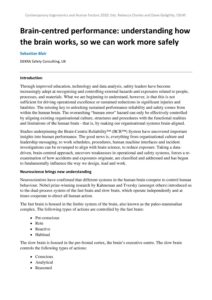| Document | Author Sebastian Blair |
| Abstract Through improved education, technology and data analysis, safety leaders have become increasingly adept at recognising and controlling external hazards and exposures related to people, processes, and materials. What we are beginning to understand, however, is that this is not sufficient for driving operational excellence or sustained reductions in significant injuries and fatalities. The missing key to unlocking sustained performance reliability and safety comes from within the human brain. The overarching “human error” hazard can only be effectively controlled by aligning existing organisational culture, structures and procedures with the functional realities and limitations of the human brain - that is, by making our organisational systems brain-aligned. Studies underpinning the Brain-Centric Reliability™ (BCR™) System have uncovered important insights into human performance. The good news is, everything from organisational culture and leadership messaging, to work schedules, procedures, human machine interfaces and incident investigations can be revamped to align with brain science, to reduce exposure. Taking a data-driven, brain-centred approach, uncovers weaknesses in operational and safety systems, forces a re-examination of how accidents and exposures originate, are classified and addressed and has begun to fundamentally influence the way we design, lead and work. |

